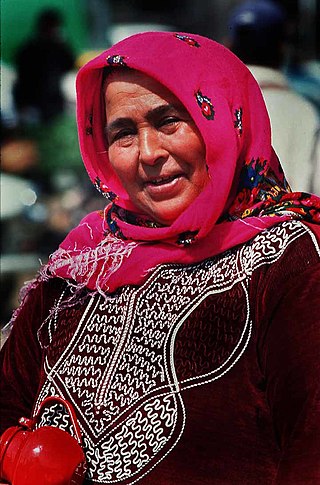Traditional gender roles
Cultural traditions often impact gender roles, prevailing cultural norms, and the interpretation of the Quran and other Islamic texts. [8]
Family
Some reformist and feminist scholars argue that the concept of guardianship has formed the basis of particular gender roles in Muslim societies. Women are often expected to be obedient wives and mothers, staying within the familial environment. Meanwhile, men are expected to be the protectors and caretakers of their families. [9] However, the majority of Muslim scholars agree that women are not obligated to serve their husbands, do housework, or do any kind of work at home. [10] [11] According to Egypt's Dar-al-Ifta, it is regarded as permissible for a woman to go out for work if she has the consent of her husband. If there is no mutual consent, then it is not permissible for her to go out and work. [12] Until the period of the rise of Islam, there were many ideas of certain actions and behaviors of women that should be expected that were considered traditional gender roles. Women were seen as inferior to men, and women were supposed to behave and respect men. In earlier times, women were seen as the housekeepers and relied on their husbands to protect them since they were thought to be not strong enough to take care of themselves. [13]
According to Sayyid Qutb, a prominent member of the Egyptian Muslim Brotherhood in the 1950s and 1960s, the Quran "gives the man the right of 'guardianship' or 'superiority' over the family structure to prevent dissension and friction between the spouses. The equity of this system lies in the fact that God both favored the man with the necessary qualities and skills for the 'guardianship' and also charged him with the duty to provide for the structure's upkeep." [14] Qutb's ideologies are still impactful for radical Islamists today, influencing such prominent Middle Eastern leaders as Ayman Zawahiri and terrorists as Osama bin Laden. [15] [16]
In Islamic culture, the roles played by men and women are equally important. Gender roles viewed from an Islamic perspective are based on the Qur'an and emphasize the dynamic structure of the family. [17] As in any socio-cultural group, gender roles vary depending on the conservative or liberal nature of the specific group.
Although there are no elaborate roles for men and women in the Qur'an, it is strongly implied that each gender provides equally significant contributions to the family realm.
Chapter 4, in verse 34, in the Qur'an, states that "men are the maintainers of women," [18] due to them providing for their family. It is implied that a noble "husband's responsibilities commit him to support his wife and children, provide education for his offspring, be kind and attentive to his spouse, and be good to his affine”. [19] These values have remained rather consistent throughout the history of Islam. It is culturally understood that women do, and should, rely on men. This is viewed not as a restricting reliance, but as an arrangement to protect women from the distress and inconveniences of the public arenas. [19] It is because of this ideology that women traditionally do not contribute to the household financially, leaving men to be the sole breadwinners.
The woman's role in the home, although different from that of men, is also of great value and importance in Islamic culture. In earlier times, from a very young age, girls traditionally grew up in the women's quarters of the house called the harem . The harem was that part of the house where the female members of the family and household lived. It was normally out of bounds to all males except the master of the house, his sons and perhaps a physician. [20] Here, young girls were familiarized with domestic activities [20] and were taught Islamic laws and values.
Femininity
What is deemed feminine, and the “ideal” Muslim woman, is constantly changing. These changes are influenced by many things, including the global market and modernization. The Quran requires Muslim men and women to dress modestly. [21] The law of the hijab states that the whole female body aside from the face and hands should be covered when a woman leaves her home [22] [23] as a sign of modesty, obedience to God and respect for Islamic values. Modernization has changed many aspects of femininity, in the past, and in the present. [24] The global market is changing femininity by showcasing and promoting images that are desirable for an ideal Muslim woman, [25] and this change has caused certain traditions for women to become outdated and contested. [26] One tradition that is becoming less accepted is the veil; some women, though not all, now see this as degrading in today's world whereas in the past it was seen as a sign of respect. [26] Regardless of traditions, women have been used throughout history as a cultural symbol of Muslim religious values, [27] which has shaped what it means to be feminine in a society.
Clothing
Several passages of the Quran deal with acceptable dress standards for both men and women. Surah 24, Verses 30-31 states:

"And tell the believing men to lower their gaze and be modest. That is purer for them and tell the believing women to lower their gaze and be modest, and to display of their adornment only that which is apparent, and to draw their veils over their bosoms, and not to reveal their adornment save to [those relatives who fall within bounds of close relationship explained in the Qur’an (i.e. the Mahrams)]..." [28]
In Iran, breaking the Islamic dress code or participation in perceived cross dressing is a crime resulting in imprisonment. [29]
Prayer and Worship
For Friday prayers, by custom, Muslim's congregations segregate men, women, and children into separate groups. On other days, the women and children pray at home. Men are expected to offer the five times daily prayers at the nearest mosque. Muhammad specifically allowed Muslim women to attend mosques and pray behind men. Mohammad said, "Do not prevent your wife(s) from going to the mosque, even though their houses are better for them," which implies women are recommended to stay at home. "A woman’s prayer in her house is better than her prayer in her courtyard, and her prayer in her bedroom is better than her prayer in her house." (Reported by Abu Dawud in al-Sunan, Baab maa jaa’a fee khurooj al-nisaa’ ilaa’l-masjid. See also Saheeh al-Jaami‘, no. 3833). [30] [ better source needed ]





